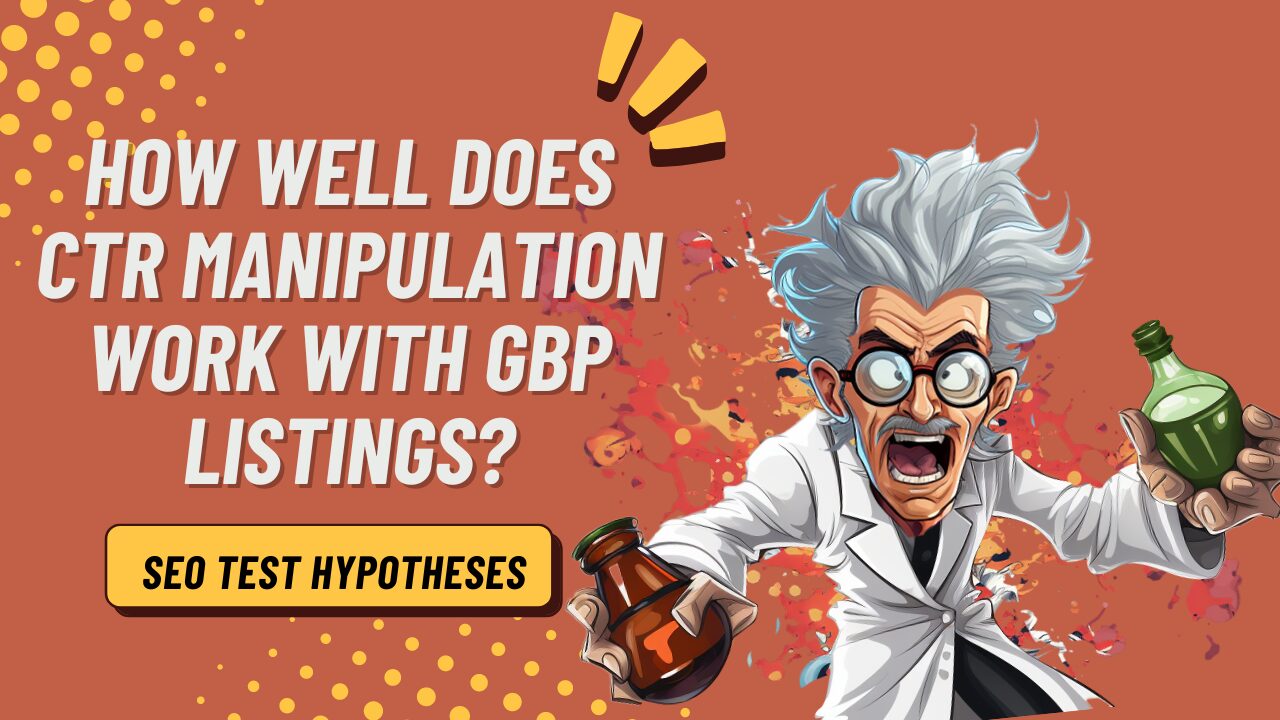Enhance Your Google My Business Listing with GMB CTR Manipulation
Enhance Your Google My Business Listing with GMB CTR Manipulation
Blog Article
Maximizing Organic Click-Through Fees With CTR Control
The optimization of organic click-through rates (CTR) is a nuanced endeavor that rests on understanding both customer psychology and reliable content discussion. By leveraging calculated control techniques, such as powerfully crafted headings and visually engaging components, marketers can substantially boost customer involvement. However, the landscape is swarming with false impressions and oversimplifications concerning what genuinely drives CTR. As we check out the ins and outs of these methods, it ends up being vital to discern the underlying concepts that can cause sustained success in capturing audience attention. What really sets apart the effective from the ineffective in this important aspect of electronic advertising?
Recognizing Click-Through Fees
Comprehending click-through prices (CTR) is crucial for examining the efficiency of internet marketing approaches. CTR determines the percentage of customers that click a particular web link or advertisement compared to the overall variety of individuals who watch it. A greater CTR indicates that the web content is involving and relevant to the target market, while a lower CTR may signify a demand for optimization.
To calculate CTR, divide the variety of clicks by the variety of impressions and multiply by 100. If an ad gets 300 clicks out of 10,000 impacts, the CTR would be 3%. This metric is critical for evaluating various aspects of electronic advertising and marketing, including seo (SEO), e-mail campaigns, and social networks advertising and marketing.
In addition, analyzing CTR aids online marketers determine which strategies generate the best outcomes and which call for refinement. By concentrating on improving CTR, organizations can enhance their web content's visibility and efficiency, leading to increased traffic and possible conversions. Recognizing the subtleties of CTR is fundamental for any kind of online marketer intending to maximize their online visibility and maximize return on financial investment (ROI)

The Psychology of User Actions
User actions is dramatically affected by emotional variables that determine how people interact with online material. Understanding these variables is essential for maximizing click-through rates (CTR) in organic search results.
Emotional responses likewise dramatically effect customer habits. Web content that resonates mentally can cause a sense of urgency or interest, prompting users to click. In addition, social evidence-- such as individual reviews or rankings-- can improve depend on and urge involvement, as individuals typically look to the habits of others to inform their very own choices.
Moreover, the concept of deficiency can drive clicks - CTR Manipulation. Limited-time offers or exclusive material develop an anxiety of losing out (FOMO), engaging users to act quickly. Recognizing these mental motorists allows online marketers to develop even more engaging material that reverberates with their target audience
Efficient CTR Adjustment Strategies
Leveraging psychological understandings can dramatically boost click-through prices (CTR) through targeted manipulation techniques. One of one of the most effective methods is making use of engaging headlines that evoke inquisitiveness or seriousness. Phrasing titles as questions or integrating find out numbers can bring in more attention, prompting individuals to click.
An additional method involves optimizing meta descriptions to produce a sense of relevance and immediacy. By plainly describing the solutions or benefits provided in the content, you can involve potential visitors and convince them to click. Furthermore, using power words-- such as "unique," "confirmed," or "complimentary"-- can enhance the charm of your web content.
Aesthetic aspects likewise play an important function. Including appealing pictures or thumbnails can attract customers in and boost CTR. A/B testing different visuals can help determine which pictures resonate finest with your target market.
Lastly, guaranteeing that your go to website material guarantees deliverable value brings about higher CTR. When individuals view that clicking will provide them with purposeful understandings or solutions, they are more most likely to involve. By utilizing these techniques attentively, online marketers can effectively manipulate CTR to their advantage while maintaining ethical standards.
Common Misconceptions Regarding CTR
A number of misconceptions border click-through rates (CTR) that can lead marketers to make misdirected choices. While a high CTR suggests that even more individuals are clicking, it does not ensure conversions or sales.
An additional usual belief is that CTR is a separated metric. In fact, CTR should be evaluated combined with various other performance indications, such as bounce price and conversion price, to obtain an alternative view of campaign success.
Furthermore, some marketers assume that enhancing for CTR alone is enough. However, concentrating specifically on CTR can lead to clickbait strategies that may attract clicks however stop working to engage customers meaningfully. This approach can hurt brand name online reputation and cause reduced retention rates
Last but not least, there is a concept that CTR methods are widely effective. The truth is that optimum CTR strategies can vary substantially throughout industries and target market, necessitating tailored methods for different market sections. Recognizing these myths is vital for establishing efficient CTR methods that line up with overarching marketing objectives.
Determining CTR Success
Although high click-through prices (CTR) can suggest successful engagement with web content, gauging their true success requires a thorough evaluation of a her response number of elements. It is necessary to understand the context in which the CTR is accomplished. A high CTR on a misleading title might not translate to purposeful engagement or conversions, ultimately reflecting badly on the brand's reputation.
Second, examining the resource of web traffic is essential. Organic website traffic from search engines can signify a durable material technique, while clicks from pointless resources may indicate an absence of targeting. In addition, determining the subsequent individual habits is crucial; analyzing metrics such as bounce rate, time invested in page, and conversion rates can provide much deeper insights right into the high quality of the engagement started by the CTR.

Final Thought

The optimization of organic click-through rates (CTR) is a nuanced venture that hinges on recognizing both individual psychology and reliable content presentation. CTR determines the percent of individuals that click on a details link or advertisement compared to the total number of customers that see it. A higher CTR shows that the material is involving and pertinent to the target audience, while a lower CTR may signal a requirement for optimization.
Concentrating specifically on CTR can lead to clickbait strategies that may attract clicks but fall short to engage customers meaningfully. In addition, determining the subsequent individual actions is important; assessing metrics such as bounce rate, time invested on page, and conversion rates can give much deeper understandings right into the top quality of the involvement initiated by the CTR.
Report this page